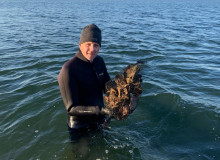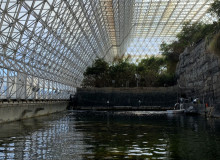ocean acidification
University of Connecticut
Science or legislation? My experience at COP27 in Sharm El-Sheikh, Egypt highlighted the importance of bringing interdisciplinary action and voices to the climate spotlight.
Georgetown University
Through regenerative aquaculture, Michael Doall is using the ecosystem services of oysters and kelp to clean up our oceans and our plates.
UA School of Journalism
You’re standing on a beach. Warm sunlight streams down, filtering through not just clouds but a geometric glass walls and ceiling. Welcome to the Biosphere 2 Ocean. Hannah Johnson reports for El Inde.
SUNY ESF
Ocean acidification is a huge threat to our oceans. Ocean acidification is an affect of climate change and the increased emissions of greenhouse gases. Carbon dioxide is absorbed in our oceans, but the oceans cannot hold everything. Too much can... Read More



